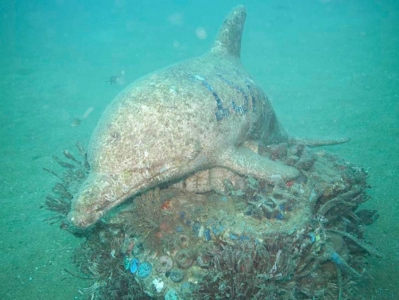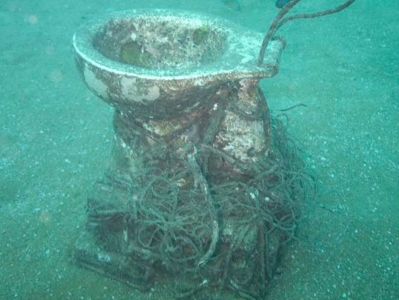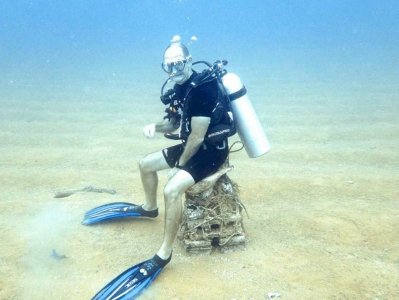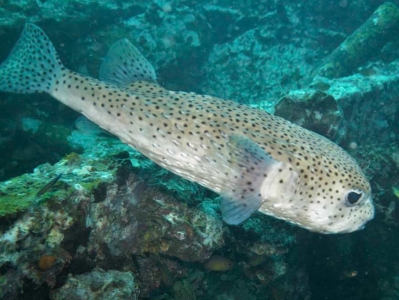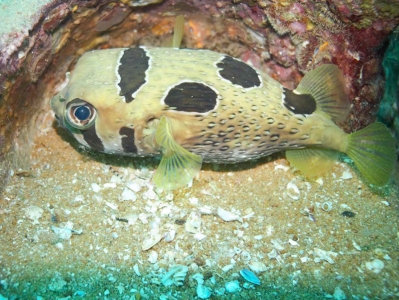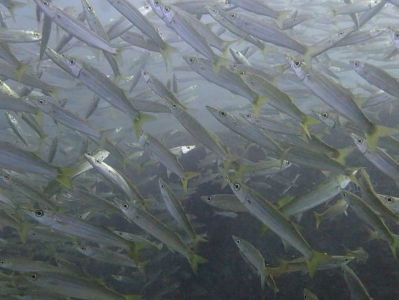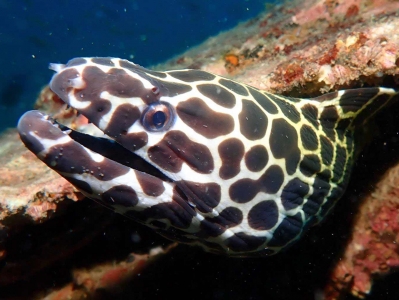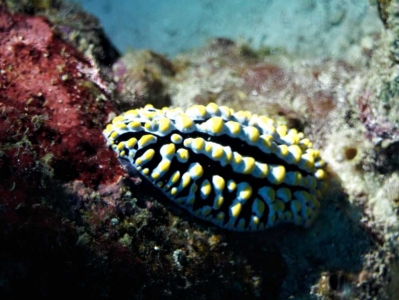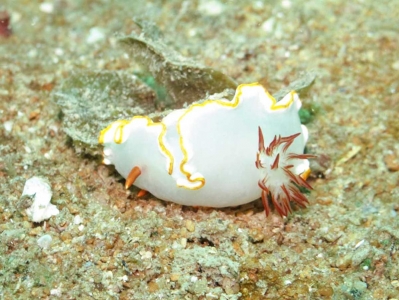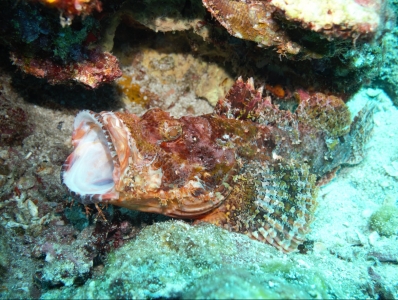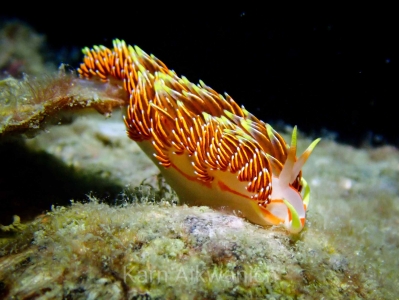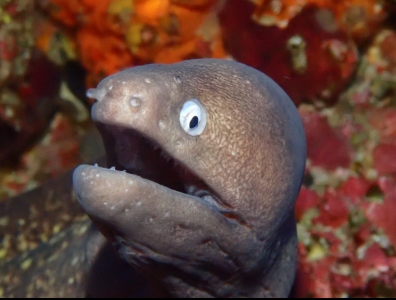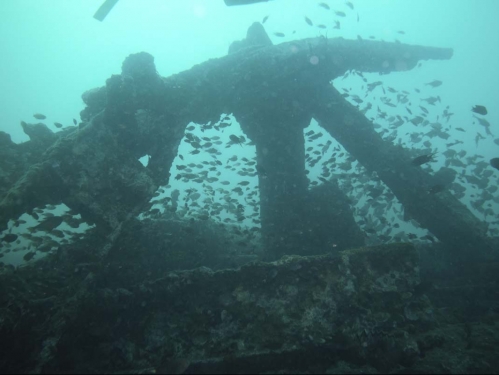 Also known by some as Bangsak Wreck, Boonsung Wreck is a very popular dive site, both for divers to visit and for a vast amount of marine life to call home. The visibility is usually not great near the surface, but the abundance of fish and invertebrates more than makes up for this.
Also known by some as Bangsak Wreck, Boonsung Wreck is a very popular dive site, both for divers to visit and for a vast amount of marine life to call home. The visibility is usually not great near the surface, but the abundance of fish and invertebrates more than makes up for this.
It's not far from the mainland at Khao Lak, just north of Phuket, so you can do a day trip there or dive it on the final day of your Similan liveaboard trip. Conditions are almost always easy, with no currents or surface waves. However, the visibility is always less clear than further out at sea. The depth of Boonsung wreck makes it ideal for the final day of the Open Water Diver course.
The highlight of the dive site is always the huge variety and quantity of marine life. In addition to large shoals of juvenile fish, you can see an abundance of Lionfish. Also, Honeycomb Moray Eels are seen here on every dive.
Boonsung Wreck
Boonsung Wreck is not a shipwreck. It’s an old dredging vessel that had been used for decades mining tin. There are various rumours about how it ended up where it is. These include its owners deciding the easiest and cheapest thing to do with it after it had ceased to become worthwhile was just sink it. Others claim that it sank by accident after a toilet became flooded. Anyway, after it sank parts of it were too near the surface, so the Royal Thai Navy destroyed sections of the wreck to make it safer for passing ships. Finally, it was further broken up by the 2004 Asian tsunami.
It's easily large enough for 30 or more divers to enjoy at the same time without being crowded. Normally each group consists of a dive guide and 4 or 5 guests. Because there are no currents, groups can easily spread out to avoid each other for the whole dive.
Although it's referred to as a wreck, it is not a ship with a hull, cabins or a bridge. Therefore, even trained wreck divers should not try to go inside. Swimming inside is very risky for several reasons. These include small chambers with no room to turn around, the high chance of silt being stirred up and reducing visibility to nothing, and the dozens of camouflaged Scorpionfish and thousands of sharp edges all over it.
In recent years the locals have placed some concrete statues around the edges, including dolphins and even a toilet.
The location of Boonsung Wreck
The location of Boonsung Wreck makes it easily accessible for day trip boats from Tab Lamu Pier and from Bangsak Beach in Khao Lak. Even a two-dive daytrip boat doesn’t need to be a fast one, and you will be back well in time for dinner. Small groups often dive Boonsung from a long-tail boat.
If you landed on this page from the top of our home page and via the 'Richelieu Rock & Surin Islands' section, then this is misleading and we apologise. Boonsung Wreck is not near Richelieu Rock of the Surin Islands. In fact, it is just a few kilometres from one of Khao Lak's main beaches.
Sea conditions
Sea conditions are usually calm at the surface during the high-season months of November to April. Under the surface, the visibility is always a topic of conversation. The visibility can range from very clear to dangerously low. In general, you can usually see approximately 10 metres in all directions, but when it's less than this you can still enjoy a great dive.
The bottom is a mixture of sand and silt, and is very flat in all directions. Currents are very rarely anything to talk about. They vary from nothing at all to very mild.
The depth of Boonsung Wreck
The depth of Boonsung Wreck is pretty consistent around the site, and it's only affected by the tides. On average, the sandy bottom is about 19-20 metres deep, and the shallowest point is approximately 14 metres. This means that Open Water Divers can enjoy all of it. And it’s also possible to do the final two dives of your Open Water Course at Boonsung. Finally, finishing a Similan liveaboard cruise at Boonsung is a popular option because you don’t go too deep, and absorb unnecessary amounts of nitrogen. However, because there’s nothing shallower than 14 metres, it’s not possible to do a multi-level dive here, so you need to keep an eye on NDL (no decompression limits).
On a normal dive here you descend directly onto any part of the wreck, and swim around clockwise or anti-clockwise. It's not important to get to a particular spot first. Therefore, groups can easily spread out in order to give everyone space. Go slow, and enjoy it all for a full hour's dive.
Things to be aware of
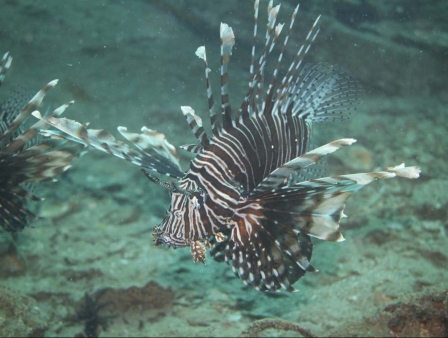 Lionfish (Photo: Alexander Kiermayer)Things to be aware of at Boonsung Wreck include venomous fish, such as the scorpionfish & lionfish, and the sharp edges of broken or decayed metal of the structure. There are also plenty of sea urchins all around. A good diver can control buoyancy and knows not to touch anything. Therefore, a good diver shouldn’t need to need to worry about any risks. There are never strong currents here, so controlling your position in the water is easy. However, divers without good buoyancy skills or those who need to hold on to get the best photo need to be very careful. This includes which parts of Boonsung Wreck are safe to touch with your hand as well as minding where your knees are.
Lionfish (Photo: Alexander Kiermayer)Things to be aware of at Boonsung Wreck include venomous fish, such as the scorpionfish & lionfish, and the sharp edges of broken or decayed metal of the structure. There are also plenty of sea urchins all around. A good diver can control buoyancy and knows not to touch anything. Therefore, a good diver shouldn’t need to need to worry about any risks. There are never strong currents here, so controlling your position in the water is easy. However, divers without good buoyancy skills or those who need to hold on to get the best photo need to be very careful. This includes which parts of Boonsung Wreck are safe to touch with your hand as well as minding where your knees are.
As we already mentioned, the visibility is often not very clear, and the dive site has a silty bottom. If anyone kicks up sand and silt, this will further decrease visibility and could cause some divers to become disorientated or even panic.
The marine life at Boonsung Wreck
The marine life at Boonsung Wreck is always the highlight. There is something for everyone, including schooling fish, eels, invertebrates and more. Very occasionally a Whale Shark pays a visit, but these sightings are extremely rare. To be honest, they probably pass by more often than divers know because everyone's looking at the wreck.
What you can be guaranteed to see here is plenty of nudibranchs, porcupinefish, lionfish & scorpionfish, Honeycomb Moray Eels, and huge shoals of juvenile species including snapper, barracuda, fusilier and more. You will soon forget about any low visibility after being immersed in a shoal of fish, or distracted by the thousands of creatures that live here.
Everyone has their own idea of which species are the stars of Boonsung Wreck. Some divers prefer the shoals of juvenile fish that use Boonsung as a nursery before they swim out into the ocean. Others like the brave, and sometimes in-your-face, porcupinefish. Honeycomb Moray Eels are quite rare out at sea around the Similan Islands, where you can see plenty of other species. But here at Boonsung you will see plenty of Honeycomb Morays, both big and small. There are also a few White-Eyed Moray Eels here if you are lucky or observant. Nudibranch lovers will not be disappointed with diving at Boonsung Wreck either. There are lots of nudibranchs, and many different species. Venomous fish are also abundant here, with lots of scorpionfish and lionfish guaranteed on every dive. The lionfish are easy to spot, and they hunt in groups, often around the sea grass. They are not bothered about divers, however close you dare to get. Scorpionfish rest on the structure, with excellent camouflage. Patient photographers will wait for them to yawn, to get the best picture.

